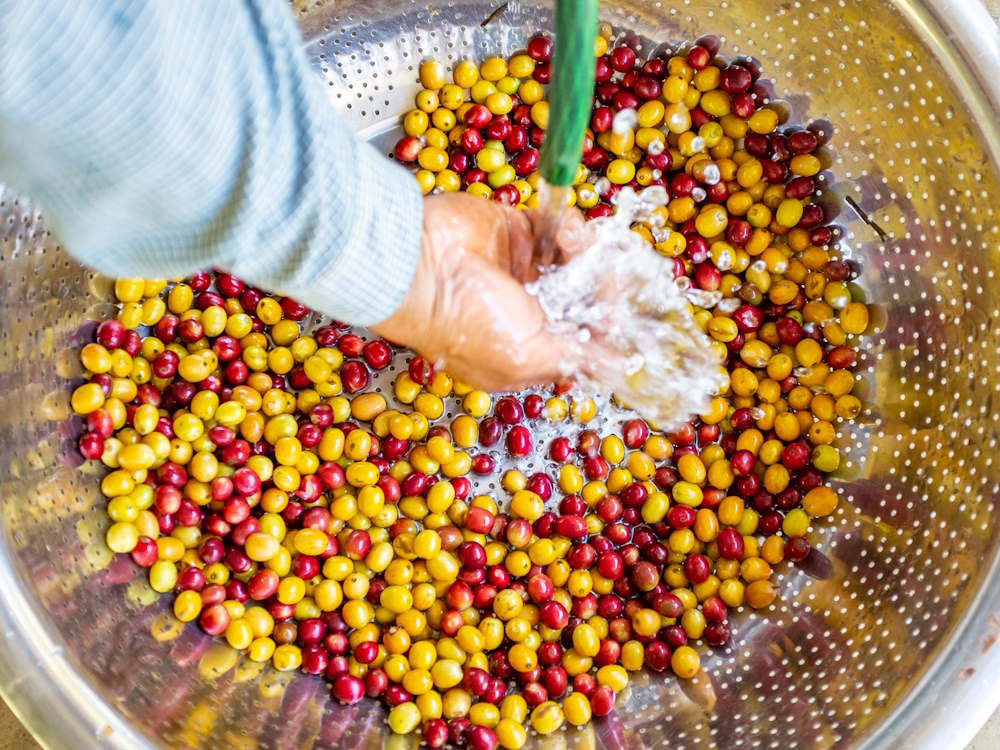The terms “infused” and “co-fermented” coffees pique the interest of many people in the industry, but not always for positive reasons. While some celebrate these processing methods for their innovation, others dismiss them under claims of inauthenticity.
Regardless of opinion, there is a tendency to group the two together. When talking about infused or co-fermented coffees, the other is usually a part of the conversation. For some, this may be instinctual. The two processing methods found the spotlight in specialty coffee roughly around the same time as each other.
However, despite a lack of formal or universal definitions, many agree that infusion and co-fermentation are not the same. This then raises the question of whether we need to treat the two processing methods differently and if grouping them together causes more harm than good.
To find out more, I spoke to Jason Kew, Marketing Business Development Manager at Sydney Coffee Business, and Vicente Mejia, founder and CEO at Clearpath Coffee, for their insight.
You may also like our article on why there is space for infused and co-fermented coffees in the industry.
Infused vs co-fermented coffees: Can we distinguish between them?
In the mid-2010s, infused coffees burst onto the specialty coffee market and captured the attention of industry professionals, competitors, and consumers alike. Unlike many “traditional” processing methods, infused coffees result in bold and unusual flavours, sparking industry-wide discussions about how producers could create such unique sensory profiles.
The answer lies in the addition of certain ingredients and flavourings, which can include essential oils, spices, acids, herbs, fruits, and vegetables. At certain stages of production (particularly during processing), producers add these ingredients to manipulate and control the final cup profile. Not only does this meet the growing demand for more unorthodox flavours, but it can also help farmers boost cup scores and add more value to their products.
Rising interest in infused coffees, however, was also a cause for concern. Without full transparency about these processing methods and how they overtly influence flavour profiles, the risk of misleading consumers inevitably increases.
Not long after infused coffees became a hot topic, the term “co-fermented coffee” also became more common. Although producers in countries like Colombia have been using co-fermentation for several decades now, the industry’s awareness of these processing methods was fairly limited until infused coffees took the specialty coffee sector by storm.
Jason Kew is the Marketing Business Development Manager at at specialty green coffee importer Sydney Coffee Business. “The growth of both infused and co-fermented coffees is driven by the rising demand for distinctive or unique flavours that entice consumers and help cafés to stand out and be competitive,” he says.
He points out, however, that the two are very different.
“We carried out sensory analysis tests on 30 different Geshas from 15 countries in a laboratory in Beijing,” Jason adds. “There are some 150 compounds that make up different flavours in coffee. For co-fermentation or controlled fermentation, some of them need to be consumed by yeasts, living microorganisms, or beneficial bacteria to produce such unique flavours.
“Meanwhile, for infusion, you can simply add synthetic chemicals and flavourings. You don’t need fermentation of any kind as the coffee beans absorb the flavours.”
Is co-fermentation more “acceptable” than infusion?
Today, the terms “infused” and “co-fermented” (and sometimes “flavoured”) coffees are often used interchangeably. With no formalised, industry-wide definitions or standards for these processing methods, it’s difficult to pinpoint exactly what they involve.
However, producers leverage fermentation in some processing techniques, including anaerobic fermentation and carbonic maceration, to imbue certain flavours. This allows us to draw comparisons with co-fermentation and build on our understanding of how it impacts sensory profiles.
For this reason, co-fermented coffees seem more widely accepted by the specialty coffee market, as opposed to infused coffees which are sometimes deemed “unnatural” and “inauthentic”.
Vicente Mejia is the founder and CEO of Colombian specialty coffee exporter Clearpath Coffee. The company works closely with producers who sell co-fermented lots.
“Both infused and co-fermented coffees are differentiated products that open up new opportunities for producers to connect with end consumers,” he says. “The difference between them is how they’re made. Infusion involves adding flavours to coffee after fermentation. Some would also say this means adding artificial flavours.
“Co-fermentation is when you add flavours from natural sources, such as fruits, herbs, and spices, during the fermentation process,” he adds. “Consumers will inevitably prefer a product that is marketed as natural.”
The industry’s preference was particularly noticeable at the 2024 Best of Panama auction. The SCA Panama chapter released a statement saying it had identified four coffees that were “altered from their natural DNA expression”. It disqualified the samples in a bid to “protect the authentic identity” of the country’s coffee sector, notably referring to them as “infused” rather than co-fermented.
“I don’t think infused coffee is specialty coffee,” says Jason. “It’s processed and artificially flavoured coffee. Co-fermentation, controlled fermentation, and terroir-focused coffees are more in line with the values of the industry.”

How can the industry benefit from distinct definitions?
Since their surge in popularity, a lack of transparency and misleading consumer perception have been key concerns about infused and co-fermented coffees. To address these apprehensions, stricter definitions of these processing methods are clearly needed.
“Infused and co-fermented coffees are developed for different markets, so we shouldn’t group them together,” Jason says. “They are distinctive from the other in terms of processing method.
“When we only focus on flavour and forget about quality, variety, terroir, and transparency, it’s easy to confuse infused and co-fermented coffees,” he adds. “Co-fermentation and controlled fermentation allow you to taste the inherent qualities of variety and terroir, but infused coffees don’t. Without proper regulations on the usage or dosage of additional synthetic ingredients, producing these lots can be risky and dangerous.”
As a result, many remain divided on where these coffees fit into the industry. According to a recent Perfect Daily Grind poll, 37% of respondents find them interesting and exciting, indicating they are open to trying or selling these coffees.
On the other hand, 33% of people surveyed said infused and co-fermented lots have no place in specialty coffee. But if we were to better distinguish between the two terms and treat them as separate from one another, positive reception is likely to increase – particularly of co-fermentation.
Ensuring producers retain value
Processing methods that allow producers to control flavour, potentially increase cupping scores, meet consumer demand for new sensory experiences, and receive higher prices are valuable. Infusion and co-fermentation are viable opportunities to capitalise on this, but full transparency from all supply chain actors is crucial.
“It’s an issue of integrity,” Vicente says. “Producers’ reputations could be harmed when they try to hide that their coffees are infused or co-fermented. In the end, consumers will decide whether they like these coffees or not, but the real problem lies in misleading them.
“Consumers should know that the flavours they taste aren’t the result of terroir alone. No coffee will taste like concentrated watermelon juice or peach jam by itself,” he adds. “The intensity of flavour notes comes from the added product added. We can’t create false expectations about how coffee with no additives tastes.
“I don’t think there is an easy way to distinguish between infused and co-fermented coffees, so maybe the best solution is to group them in the same category,” he concludes. “But roasters and producers need to be transparent and communicate how the coffee has these unique flavours.”

Despite a lack of formal or universal definitions, there are clear differences between co-fermented and infused coffees. Both have a place in the market, but to improve transparency, we need to better distinguish between the two.
By doing so, we can address the major points of contention about these coffees. As a result, the industry can find the best “homes” for infused and co-fermented lots.
Enjoyed this? Then read our article on infused and co-fermented coffees at the World Barista Championship.
Perfect Daily Grind
Want to read more articles like this? Sign up for our newsletter!
The post Should we treat infused and co-fermented coffees differently? appeared first on Perfect Daily Grind.

